Existential SentenceLecture28
英语语法

Lecture 2 and 3 Subject-verb Concord主谓一致Basic terms:concord /agreement, subject-verb concord / agreement (SV agreement), grammatical concord, notional concord, principle of proximity, disease names, game names, subject names, coordinate subject, expressions of quantity as subject, expressions of definite quantity, expression of indefinite quantity, nominal clause, non-finite clause, relative clause, cleft-sentence, existential sentence2.1 Guiding principles指导原则:1). Grammatical concord语法一致:He goes to school on foot.Few students are really lazy.2).notional concord意义一致: The audience was enormous.The audience were greatly moved at the words.3).principle of proximity就近原则[动词单复数依其紧挨着的作(真)主语的名词的单复数]:Either my brothers or my father is coming.Either my father or my brothers are coming.Not only one, but all, of us are hoping to be there.There is no easy answer to the question which principle will be used in a given sentence. Sometimes the usage counts.The following are rules for different types of subjects or sentences.2.2 Problems of concord with nouns ending in -s:*1).disease names and game names ending in –s:2).subject names ending in –ics (physics,mathematics, athletics, tactics,etc. ): usu sing.指学科时常跟单数动词Mathematics is the study of numbersEthics(伦理学)deals with moral conduct(道德行为).Exceptions: 这类名词指学科以外的意义时一般多用复数:The acoustics(音响效果,而非―声学‖)in the new concert hall are faultless.Government statistics(统计数字,而非―统计学‖)indicate that prices have gone down.有的单复数动词均可:My mathematics(运算能力) is/are rather shaky(靠不住的).3).geographical names ending in -s (The United States, the United Nations, the Netherlands )几类以-s结尾的地理名称:*4. Other nouns ending in –sa. things of 2 parts: usu. pl.b. Some plural nouns ending in –s are usually followed by plural verbs. These nouns include archives, arms, clothes, contents etc. (for more words see p.32)e.g. The contents of this book are most fascinating.High wages often result in high prices.His thanks are most profuse.Exceptions: His whereabouts (行踪)were /was known only to his personal staff.The dramatics (舞台艺术)of the performance were /was marvelous.c. nouns ending in –ings: Usu Pl. The findings show that he is guilty. Her sufferings are dreadful.Exceptions: Sing. /Pl. : Tidings,doings: Where is/are the doings(那东西) to open this with?d.nouns which end in –s and whose singular and plural number share the same form (单复数同形)are followed by singular or plural verbs according to different senses(意义)of these nouns:A series of pre-recorded tapes has been prepared for language lab use.There are two series of readers: one for beginners and one for advanced students.Note:单复数同形名词另有fish, deer等,参见第4讲有关部分。
Lecture29
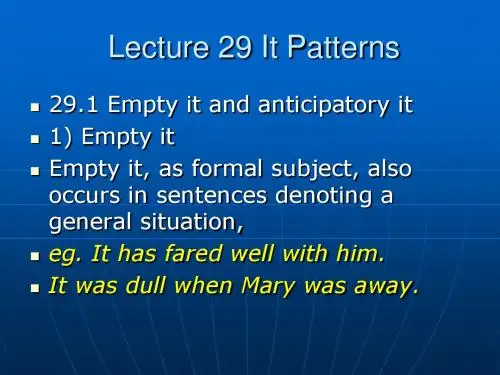
29.2 It as introductory word of cleft sentences
1) Cleft sentence defined A cleft sentence is an emphatic construction with non-referring it as nonformal subject. It is also called because it is formed by dividing a single statement into two separate parts each with a verb of its own. It + be + focal element + that/ whowhoclause
2) Introductory it in cleft sentences vs anticipatory it
The introductory it of a cleft sentence is functionally different from an anticipatory it: the introductory it does not stand for any extraposed subject, while an anticipatory it does. 3) Pseudo-cleft sentences PseudoA pesudo-cleft sentence is essentially an pesudoSVC construction with a what-clause as whatsubject. Eg. I gave her a handbag. →What I did was (to) give her a handbag.
Existential Sentence and It-petterns
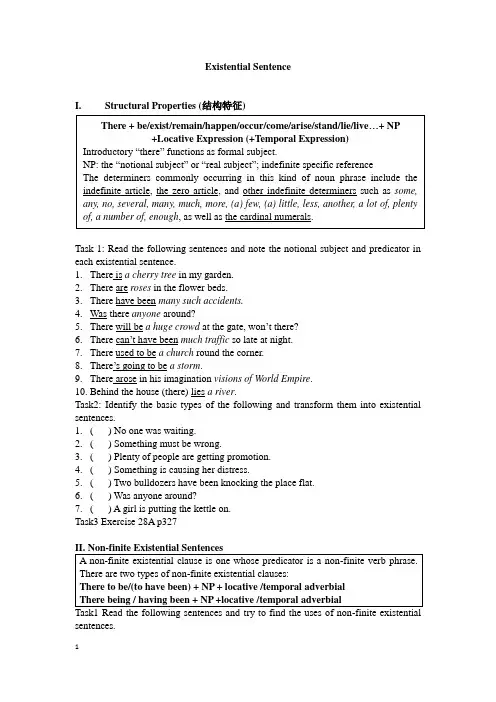
Existential SentenceI.Structural Properties (结构特征)Task 1: Read the following sentences and note the notional subject and predicator in each existential sentence.1.There is a cherry tree in my garden.2.There are roses in the flower beds.3.There have been many such accidents.4.Was there anyone around?5.There will be a huge crowd at the gate, won’t there?6.There can’t have been much traffic so late at night.7.There used to be a church round the corner.8.There’s going to be a storm.9.There arose in his imagination visions of World Empire.10.Behind the house (there) lies a river.Task2: Identify the basic types of the following and transform them into existential sentences.1.( ) No one was waiting.2.( ) Something must be wrong.3.( ) Plenty of people are getting promotion.4.( ) Something is causing her distress.5.( ) Two bulldozers have been knocking the place flat.6.( ) Was anyone around?7.( ) A girl is putting the kettle on.Task3 Exercise 28A p327sentences.1.They planned for there to be another meeting.2.Jane was relying on there being another opportunity.3.Members like there to be plenty of choices.4.There being a bus stop so near the house is a great advantage.5.It was unusual for there to be few people in the streets.6.There having been no rain, the ground was dry.Task2 Exercise28B p329Task3 Exercise28C p329Keys:I. Structural Properties (结构特征)Task2: Identify the basic types of the following and transform them into existential sentences.1.(SV) There was no one waiting.2.(SVC) There must be something wrong.3.(SVO) There are plenty of people getting promotion.4.(SV oO) There’s something causing her distress.5.(SVOC) There have been two bulldozers knocking the place flat.6.(SV A) Was there anyone around?7.(SVOA) There’s a girl putting the kettle on.II. Non-finite Existential SentencesTask1 Read the following sentences and try to find the uses of non-finite existential sentences.1.There to be: uses as prepositional complement (if the preposition is for, it usuallytakes the “there to be” form as a complementation).2.There being: used as prepositional complement (With other prepositions, thecomplementation usually takes the “there being” form).3.There to be: used as object (this applies more often than not to the “there to be”form. There are only a limited number of verbs that can take a “there to be” form as object. These verbs include expect, mean, intend, want, like, prefer, hate, etc.).4.There being: used as subject5.For there to be: used as subject (As subject, the “there being” form is commonlyused; when “there to be” form is used as subject, it is introduced by for, eg: For there to be few people in the street was unusual. )6.There being: acts as adverbial1.It’s illegal to drive without a license.2.It was Jim that /who called this morning.3.It is surprising that Mary should have won the first place.4.It may have been at Christmas that Jim gave Mary a handbag.5.It is very warm and wet in South China these days.6.It seemed a long time before my turn came.7.It was pleasant meeting you in Longde that day.8.I made it clear that I didn’t want to speak to him.9.It happened that Xiao Li was the only witness.10.It looked as if the college is very small.11.Hop it. You are in the way here.12.If you break the law, you can’t get away with it.I Empty itTask1 Translate the following sentences, using “it” wherever possible.1.冬天,天色晚得早。
存在句练习及答案
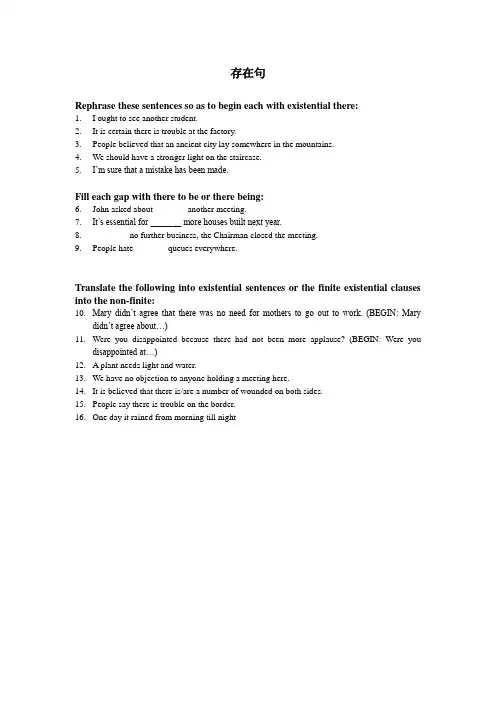
存在句Rephrase these sentences so as to begin each with existential there:1.I ought to see another student.2.It is certain there is trouble at the factory.3.People believed that an ancient city lay somewhere in the mountains.4.We should have a stronger light on the staircase.5.I’m sure that a mistake has been made.Fill each gap with there to be or there being:6.John asked about _______ another meeting.7.It’s essential for _______ more houses built next year.8.________ no further business, the Chairman closed the meeting.9.People hate _______ queues everywhere.Translate the following into existential sentences or the finite existential clauses into the non-finite:10.Mary didn’t agree that there was no need for mothers to go out to work. (BEGIN: Marydidn’t agree about…)11.Were you disappointed because there had not been more applause? (BEGIN: Were youdisappointed at…)12. A plant needs light and water.13.We have no objection to anyone holding a meeting here.14.It is believed that there is/are a number of wounded on both sides.15.People say there is trouble on the border.16.One day it rained from morning till nightKeys:1.There’s another student (that) I ought to see.2.There’s certain to be trouble at the factory.3.There were people who believed that an ancient city lay somewhere in themountains.4.There should be a stronger light on the staircase.5.There must have been a mistake.6.there being7.there to be8.There being9.there to be10.Mary didn’t agree about there being no need for mothers to go out to work.11.Were you disappointed at there not having been more applause?12.There is no plant that doesn’t need light and water.13.We have no objection to there being a meeting here.14.There is/are believed to be a number of wounded on both sides.15.There is said to be trouble on the border.16.There was a day when it rained from morning till night.。
英汉语言对比-习题·+答案
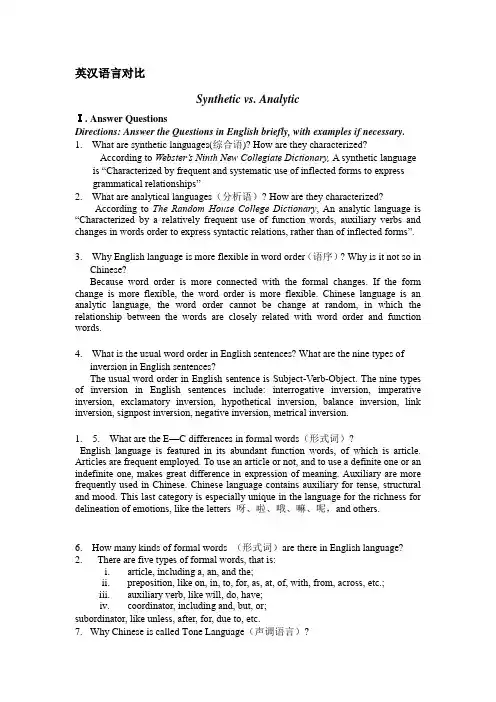
英汉语言对比Synthetic vs. AnalyticⅠ. Answer QuestionsDirections: Answer the Questions in English briefly, with examples if necessary. 1.What are synthetic languages(综合语)? How are they characterized?According to Webster’s Ninth New Collegiate Dictionary, A synthetic language is “Characterized by frequent and systematic use of inflected forms to express grammatical relationships”2.What are analytical languages(分析语)? How are they characterized?According to The Random House College Dictionary, An analytic language is “Characterized by a relatively frequent use of function words, auxiliary verbs and changes in words order to express syntactic relations, rather than of inflected forms”.3.Why English language is more flexible in word order(语序)? Why is it not so inChinese?Because word order is more connected with the formal changes. If the form change is more flexible, the word order is more flexible. Chinese language is an analytic language, the word order cannot be change at random, in which the relationship between the words are closely related with word order and function words.4.What is the usual word order in English sentences? What are the nine types ofinversion in English sentences?The usual word order in English sentence is Subject-Verb-Object. The nine types of inversion in English sentences include: interrogative inversion, imperative inversion, exclamatory inversion, hypothetical inversion, balance inversion, link inversion, signpost inversion, negative inversion, metrical inversion.1. 5.What are the E—C differences in formal words(形式词)?English language is featured in its abundant function words, of which is article. Articles are frequent employed. To use an article or not, and to use a definite one or an indefinite one, makes great difference in expression of meaning. Auxiliary are more frequently used in Chinese. Chinese language contains auxiliary for tense, structural and mood. This last category is especially unique in the language for the richness for delineation of emotions, like the letters 呀、啦、哦、嘛、呢,and others.6.How many kinds of formal words (形式词)are there in English language?2.There are five types of formal words, that is:i.article, including a, an, and the;ii.preposition, like on, in, to, for, as, at, of, with, from, across, etc.;iii.auxiliary verb, like will, do, have;iv.coordinator, including and, but, or;subordinator, like unless, after, for, due to, etc.7.Why Chinese is called Tone Language(声调语言)?Chinese tone can be used for indicating the change of meaning and is not suitable for expressing the certainty, completeness, independence or finality.Ⅱ. Fill in the BlanksDirections: Fill in the blanks with the best answer you have found in the textbook.1.11.综合语的特征是经常性、系统性的运用曲折形式来表现语法关系为特征的语言,分析语的特征是分析语的特征是相对频繁地使用功能词,助词和改变词序来表达句法关系,而不用曲折形式来表达。
法律逻辑学讲义lecture
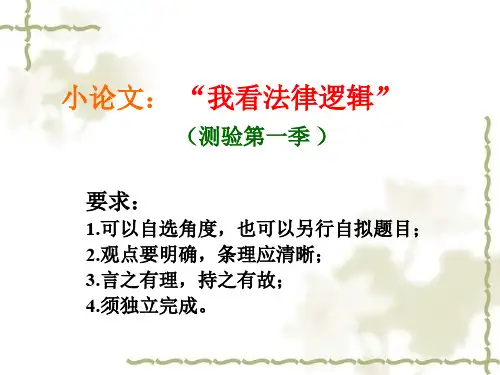
(测验第一季 )
要求:
1.可以自选角度,也可以另行自拟题目; 2.观点要明确,条理应清晰; 3.言之有理,持之有故; 4.须独立完成。
2
2020年1月6日星期一
命题论
命题的一 般特征
3
一、命题的一般特征
2020年1月6日星期一
1.符号、语句、命题与判断
1.1.符号 符号(sign,symbol) ,亦称指号或记
■ 所谓分歧,就是不一致。 ■ 任何分歧都可归约为两种:
信念分歧(the disagreement in beliefs) 态度分歧(the disagreement in attitudes)
延伸阅读:[美]查尔斯·L·斯蒂文森著:《伦理学与语言》, 姚新中等译,中国社会科学出版社1991年版。
18
陈述与语句,有时不作严格区分。 例如:
① 昨天两路镇发生一起车祸 ② 那束玫瑰很好看
8
2020年1月6日星期一
1.3.命题(proposition)
命题,就是具有真假值的语句,换言之,就是一 些或真(true)或假(false)的句子。
命题的真和假称为命题的真值(truth value,简 称为truth)。传统逻辑是二值逻辑,其经典命题 必须是具有真、假两种逻辑值的语句。
判断总是同认识主体(断定者)相联系的 (即“必问出处”),而命题则不涉及认 识主体(即“不问来路”)。
12
2020年1月6日星期一
2.命题的不同分类
2.1.描述命题与评价命题
法国哲学家笛卡尔(R. Descartes)最先根据 命题的内容及性质不同作这种区分;
后来,英国哲学家休谟(D. Hume)对此进行 过深入的探讨。
Existential Sentence
(2)The predicator may also be realized by “modal+be/have been”.eg:
There must be no more money wasted . Mustn’t there be another reason for his behavior? There can/can’t be very little doubt about his guilt. There can’t have been much traffic so late at night. There used to be a church round the corner.
(4)Apart from this,there are at least three classes of semantically-related verbs that can act as predicator.
Verbs of existence and position.such as exist,live,stand,lie Verbs of motion,such as come,go,walk Verbs of emergence or development ,such as:appear,arise ,emerge ,develop,happe n,occur,etc.
Non-finite existential clauses
A non-finite existential clauses is one whose predicator is a non-finite verb phrase .There are two types of non-finite existential clauses : There to be/(to have been) +NP+locative/temporal adverbial There being/having been +NP+locative/temporal adverbial
存在句(There be)
• Behind the village flows a murmuring stream.
12
• Eg. There can be very little about his guilt. • There are many desks in the classroom. • There used to be a hospital round the corner. • There appears to be no doubt about it. • There stands a house behind the tree. • Behind the tree (there )stands a house.
5
存在句的谓语动词
• 存在句的谓语动词主要是动词be的某种形 式, 分限定形式和非限定形式。
• 限定形式:一般现在时、一般过去时、现 在完成体、过去完成体和情态助动词+不定 式。除be外, 某些表示存在意义的不及物 动词如:exist, remain, occur, stand, lie等, 能用于there存在句。地点状语前移,there 可省。
• There arose in his imagination visions of a world empire.
• Long, long ago, there lived six blind men in India.
• The existential sentence can be inverted by shifting the locative adverbial to the initial place of the sentence.
Long, long ago, there lived a king. 2). 然后有人敲门。
Lecture28
The predicator or predicate verb of an existential sentence is commonly a form of the verb be, finite or nonnonfinite, simple or perfective. The, predicator may also be realized by “modal + be/have been ” or “semisemiauxiliary + be” be” Eg. There can be very little doubt about his guilt. There can’t have been much traffic so canIntroductory there
Introductory there functions as formal subject not only in statements but also in questions, where the formal subject and operator are inverted. 2) Notional subject The notional subject, which is actually the focus of information, is usually a noun phrase with indefinite specific reference. The determiners include the indefinite article, the zero article, and other indefinite determiners such as some, any, no, several, many, much, more, (a)few, (a) little, less, another, a lot of, plenty of, a number of, enough, etc..
第6讲和第7讲存在句和IT句
It’s important for there to be a fire-escape.
2. There being a bus stop so near the house is a great advantage. 在房子附近有公交车站是个很大的优势。 3. 他们计划再开一次会议。
They planned for there to be another meeting.
This is the fastest train there is to Beijing.
This is the fastest train that there is to Beijing.
Lecture Seven It-Patterns
Three types of sentence with non-referring it as formal subject: 1) sentences with it (empty it) as formal subject denoting time, distance, and atmospheric conditions; 2) sentences with anticipatory it (anticipatory it) as subject; 1) cleft sentences introduced by it (introductory it).
A Lead-in
24. ____ to be nobody working in the room when the fire broke out. A. There happened B. It happened C. There being D. It took place
Lecture Six Existential Sentence
- 1、下载文档前请自行甄别文档内容的完整性,平台不提供额外的编辑、内容补充、找答案等附加服务。
- 2、"仅部分预览"的文档,不可在线预览部分如存在完整性等问题,可反馈申请退款(可完整预览的文档不适用该条件!)。
- 3、如文档侵犯您的权益,请联系客服反馈,我们会尽快为您处理(人工客服工作时间:9:00-18:30)。
28.1 Structural properties of existential sentences The existential sentence generally begins with an unstressed there as formal subject followed by a form of the verb be or other verb that is related to the notion of existence. Pattern: There + be + NP + locative/ temporal adverbial
1) Introductory there
Introductory there functions as formal subject not only in statements but also in questions, where the formal subject and operator are inverted. 2) Notional subject The notional subject, which is actually the focus of information, is usually a noun phrase with indefinite specific reference. The determiners include the indefinite article, the zero article, and other indefinite determiners such as some, any, no, several, many, much, more, (a)few, (a) little, less, another, a lot of, plenty of, a number of, enough, etc..
3) Predicator in existential sentence
28.2 Non-finite existential clauses
1) As prepositional complementation Eg. They planned for there to be another meeting. John was relying on there being another opportunity. 2) As object Eg. Members like there to be plenty of choice. 3) As subject and adverbial Eg. It was unusual for there to be so few people in the streets.
ห้องสมุดไป่ตู้
The predicator or predicate verb of an existential sentence is commonly a form of the verb be, finite or nonfinite, simple or perfective. The, predicator may also be realized by “modal + be/have been ” or “semiauxiliary + be” Eg. There can be very little doubt about his guilt. There can’t have been much traffic so late at night.
